After the fantastic day spent with Joao, I returned to the hotel where I had additional reasons to be happy and content – my “lost” bag was finally waiting for me at the reception. I was complete.
I took the bag up to my room and then I returned to the terrace in front of the hotel where I could relax nicely, so I ordered “green wine” – vinho verde. This is a Portuguese wine (from the continental part of the country) which is not green at all (suggested by the literal translation), but rather the name in fact means “young wine.” Be as it may, it was recommended to me by a Portuguese guy I was sitting next to on my flight here, so I decided to act on the recommendation. On the other hand, I did something I normally don’t do – I ordered an entire bottle, but I had only one glass. The bottle was then closed well and put into a fridge belonging to the hotel where my wine waited for me the next evening.
Then I went up to my room, but I first sat for a little while on the spacious terrace in front of my room and from there I watched a cruiser that seemed to be turning around in the same spot probably trying to park.
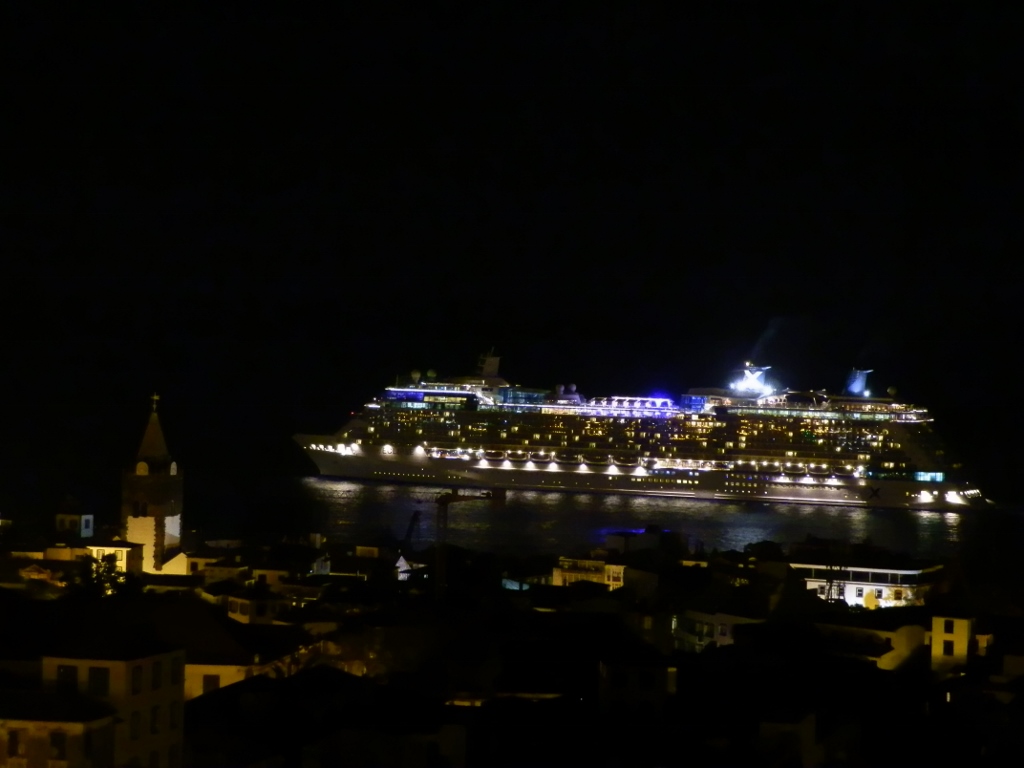 The cruiser, as well as the bell tower of the Cathedral in Funchal at night
The cruiser, as well as the bell tower of the Cathedral in Funchal at night
I was also thinking that the life “had the meaning again.” My bag had arrived and that really made me happy. In addition, the day was absolutely great! Joao was incredibly sweet and kind and he spent the entire day, from 8.30 in the morning until 7 in the evening, with me taking me around Madeira. Although we had never met before that morning, it turned out we had a lot of common topics and the two of us did not stop chatting the whole day. About all sorts of things. He is such a wonderful human being and a fantastic genius!
Because of all of this I was very content for coming to Madeira. On the basis of what I saw during a couple of days I concluded that this was a fabulous island – impressive history and architecture, fantastic geography, valleys, mountains, nature, ... An absolutely gorgeous island; relatively small, but fantastically pretty. I was very happy to have (finally) come here.
The next morning I got up a little earlier again in order to have breakfast before Joao came to pick me up. The only problem in all of this was the fact that my throat felt a little sore. I thought: “There, all that intensive work during the previous month when I exhausted myself beyond any normal level came up for the collection and my immune system is weakened now.” But, apart from informing Joao that I had sore throat, just so that he would have the information in case I was contagious, nothing else changed.
On yet another wonderful sunny day we headed for the east side of the island. First we got to Santa Cruz that is located between Funchal, the capital of Madeira, and the international airport, and there we went to a fish market right away. The most interesting for me was a type of dried fish that could be found here in abundance. This was skipjack tuna that is caught around Madeira and that is very popular here. Its dry version sold here is called gaiado seco in Portuguese.
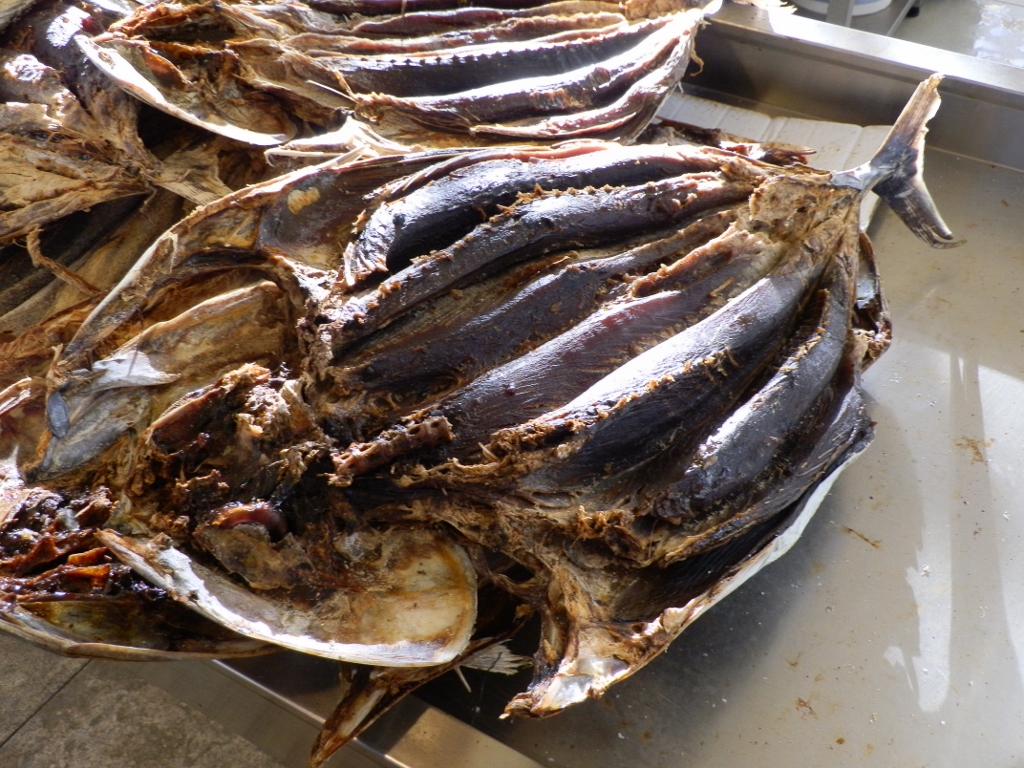 Dry tuna
Dry tuna
Next to the beach there is a small park, but we walked only around the centre where we went to the main square. There is the Church of San Salvador, meaning the Church of Holy Saviour (Igreja de São Salvador). This church was made in the 17th century by restoring a chapel that used to be in that spot. This is also the second largest church on Madeira, but I was not in the mood at all and not keen on sightseeing on this day, so I did not enter. Still, from the outside, it certainly looked pretty.
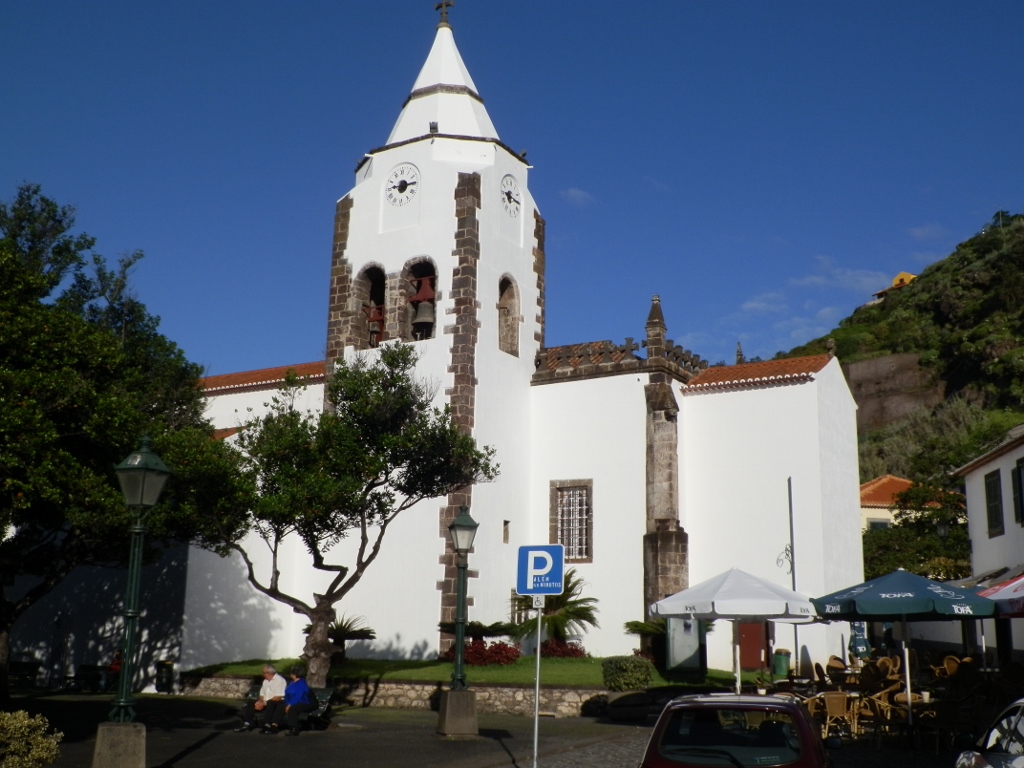 Igreja de São Salvador
Igreja de São Salvador
While we were walking along the streets of Santa Cruz I was actually looking for a pharmacy to buy something for my sore throat, but I did not give up on taking photos.
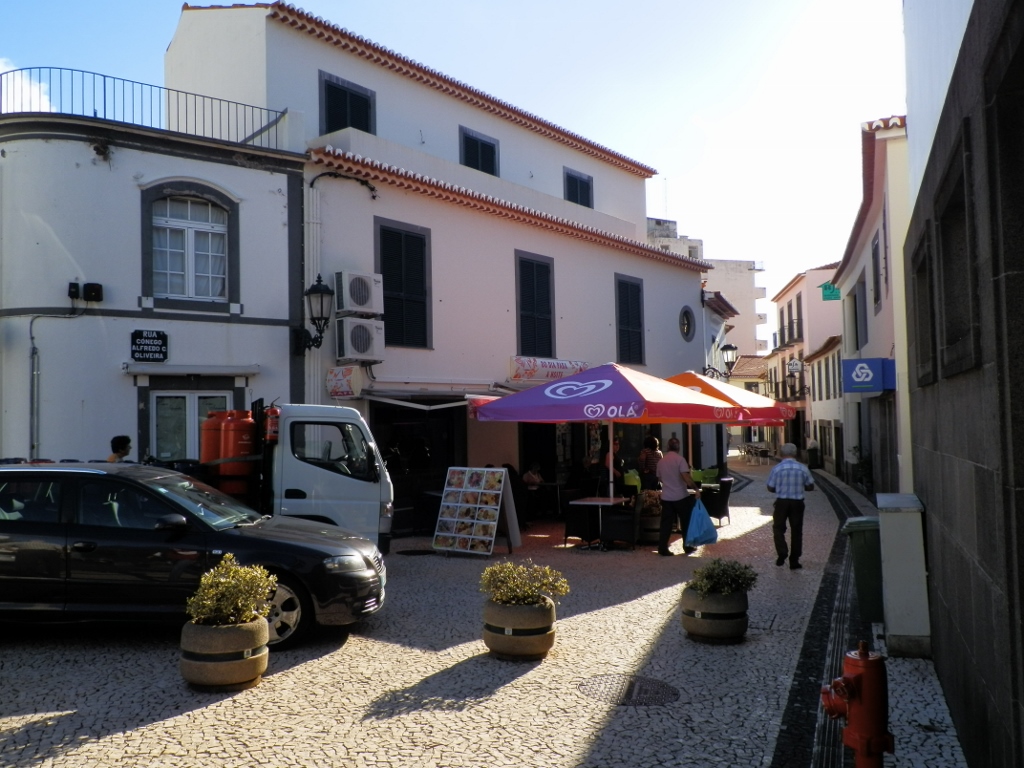 A street in Santa Cruz
A street in Santa Cruz
Then we returned to the car continuing further to the east. Along the way we passed UNDER the runway of the international airport on Madeira.
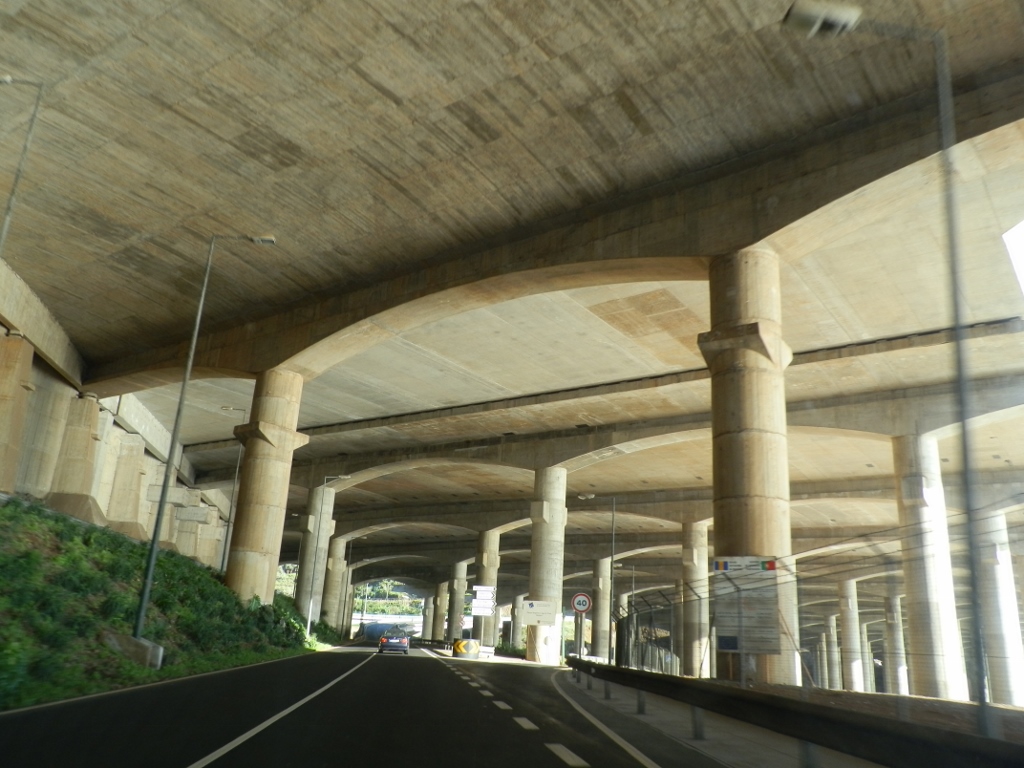 Pillars carrying the airport runway
Pillars carrying the airport runway
The airport on Madeira is a very interesting place for several reasons. First, Madeira is very hilly and it has very few flat parts where it would make sense to build an airport. That is why by using the concrete pillars seen in the photo above they managed to extend artificially the runway for the landing of bigger planes. Because of the specific structure of the airport, it has even received some international civil engineers’ award.
The second reason why this airport is interesting is that because of the hills and cliffs around it and the abrupt drop of the land at the end of the runway, this airport is considered one of the most dangerous in the world as far as landing is concerned. The History Channel has declared it the ninth most dangerous airport in the world and the third most dangerous airport in Europe. And that is not all. The pilots who are chosen to fly the planes to land here must undergo special training for the landing on this airport.
And even that is not all! The third reason that makes this airport, colloquially called Madeira or Funchal airport, interesting is its official name. The airport is officially called Cristiano Ronaldo International Airport, Madeira after the currently most famous son of this island – footballer Cristiano Ronaldo who was born on the island in 1985.
On this occasion, we only drove under and past the runway and continued to a town called Machico.
Machico used to be the second most important town on Madeira, although it was actually here that João Gonçalves Zarco landed in 1419 when he “discovered” Madeira. With time, Machico has lost its important position and today it is “only” a nice tourist and agricultural town.
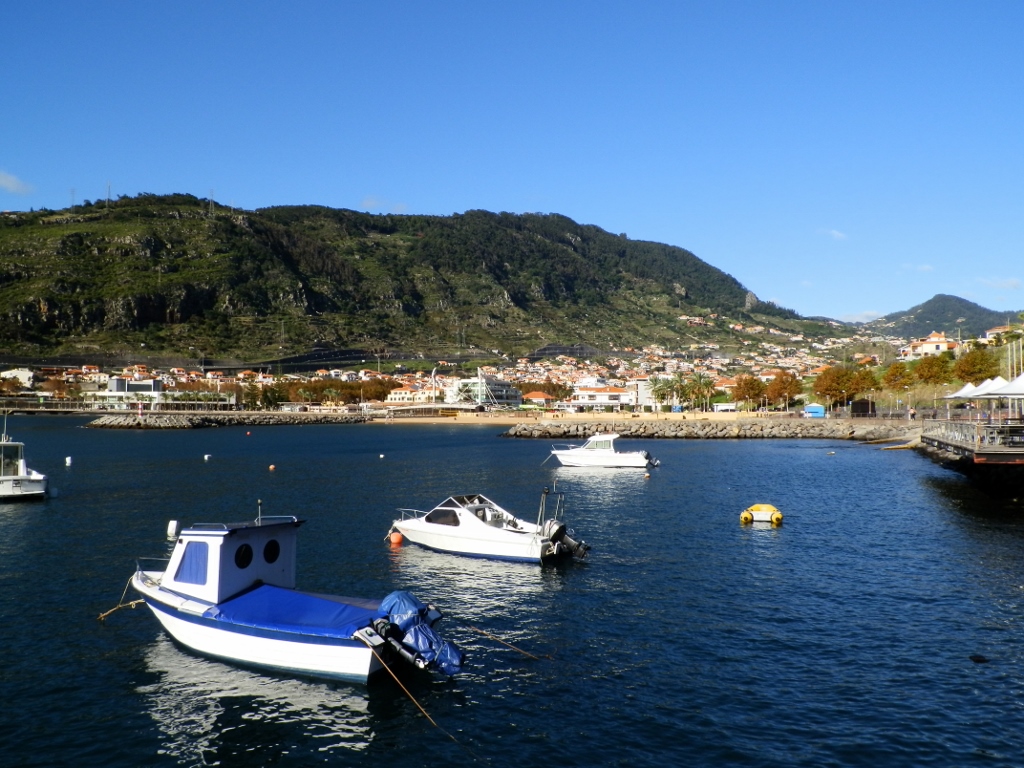 Machico
Machico
A part of the bay at Machico also has a very impressive beach.
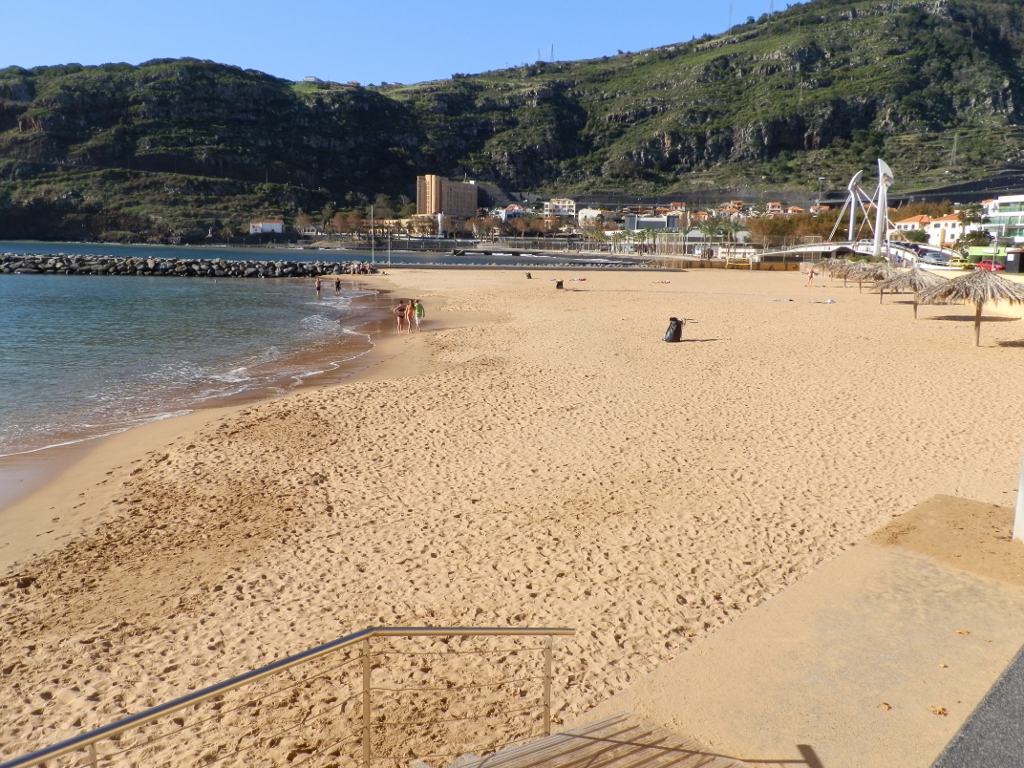 Beach in Machico
Beach in Machico
However, what is interesting about this is that there are no sandy beaches on Madeira; they are all rocky. Still, when one sees the photo above and the sand on the beach in Machico this information seems confusing. The point is that this information is not incorrect, but only incomplete. Namely, the sand seen in the photo above had been imported from north Africa and brought here and to one other place on Madeira. Naturally, there is no sand on the beaches of Madeira.
But, what is here is a fortress and so Joao and I went to see it. The fortress is called Forte de Nossa Senhora do Amparo and it is rather small, serving to provide defence for the anchorage against the attacks by pirates. It was built in 1706, has a triangular ground plan and today there are a few old canons leaning against the not too high ramparts just to make the whole thing more plausible.
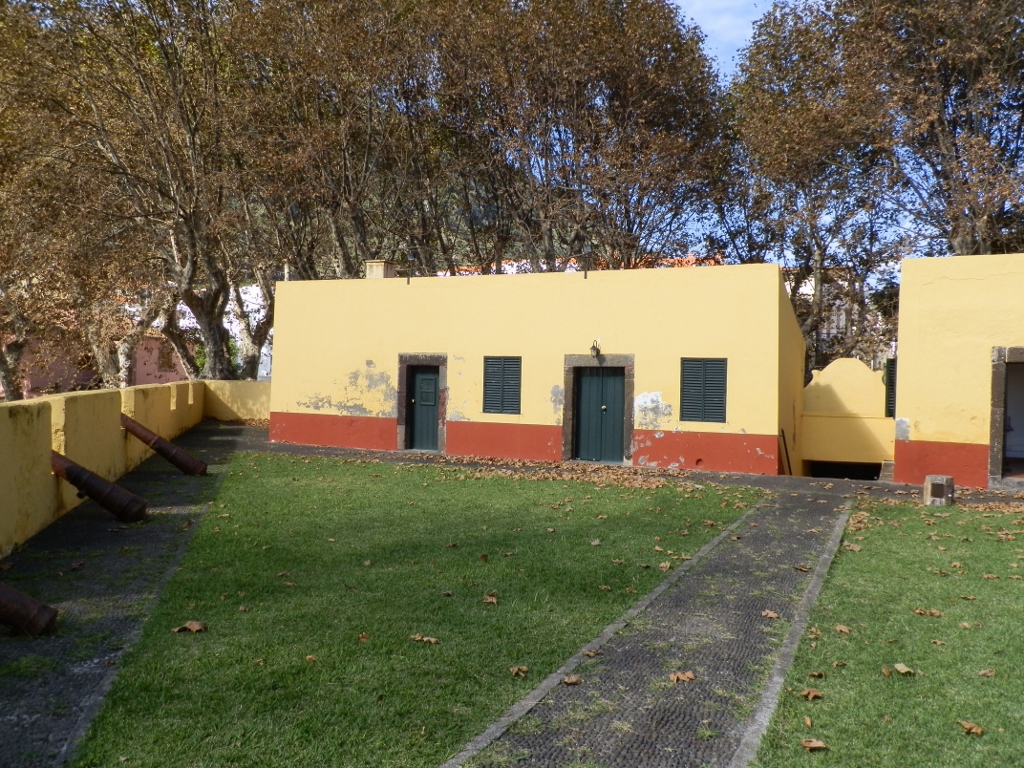 Fortress in Machico
Fortress in Machico
One corner of the triangular fortress faces the ocean and parallel to the side of the fortress opposite that corner there is a street with a very nice line of trees.
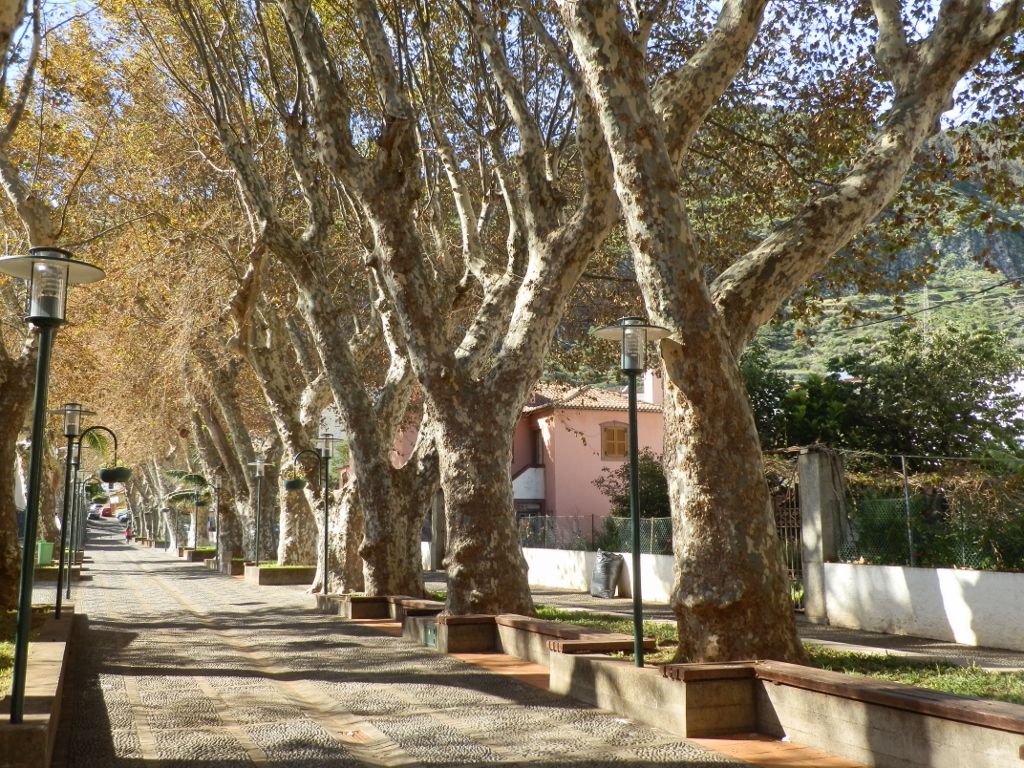 Nice line of trees in Machico
Nice line of trees in Machico
We also passed by a pretty building of the Municipality in Machico, while across the street there is the main church in the town.
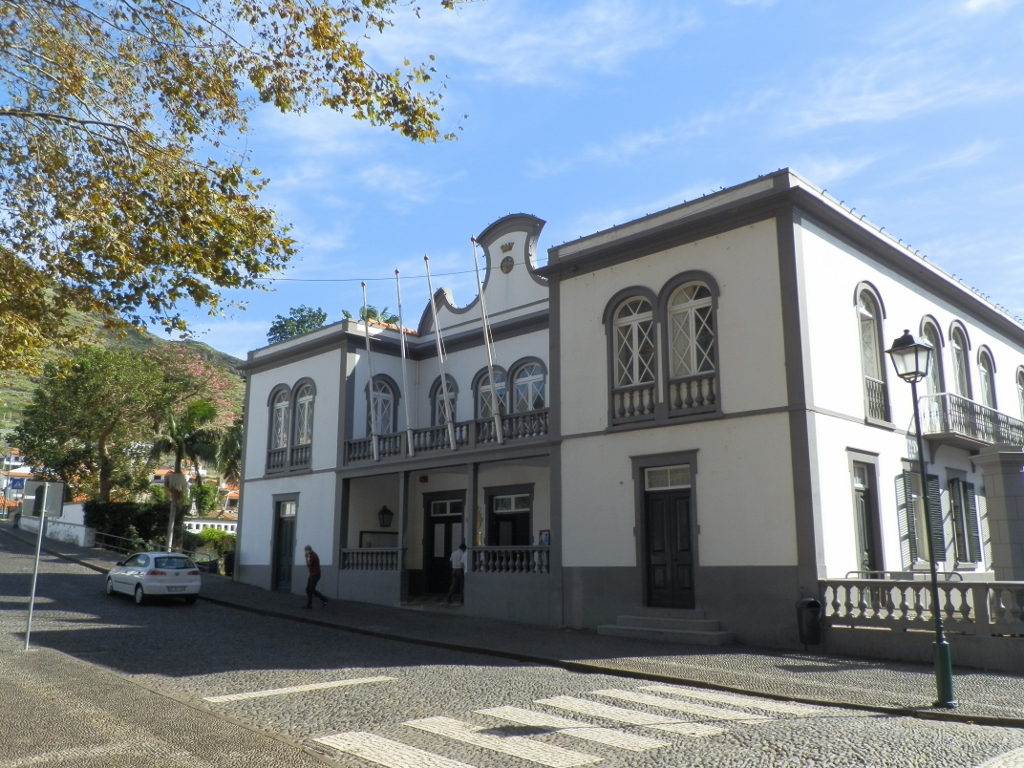 Municipal building in Machico
Municipal building in Machico
As far as the church is concerned, this is the Church of Our Lady of Conception (Igreja de Nossa Senhora da Conceição) built in the second half of the 15th century. Its construction was financed by the family of Tristão Vaz Teixeira who alongside Zarco was one of those who discovered Madeira and one of the first to settle here. In addition, in 1440 Madeira was administratively divided into two parts and Teixeira and his descendents were granted the captaincy of Machico. For this reason, there is a statue of Teixeira on the square in front of the church.
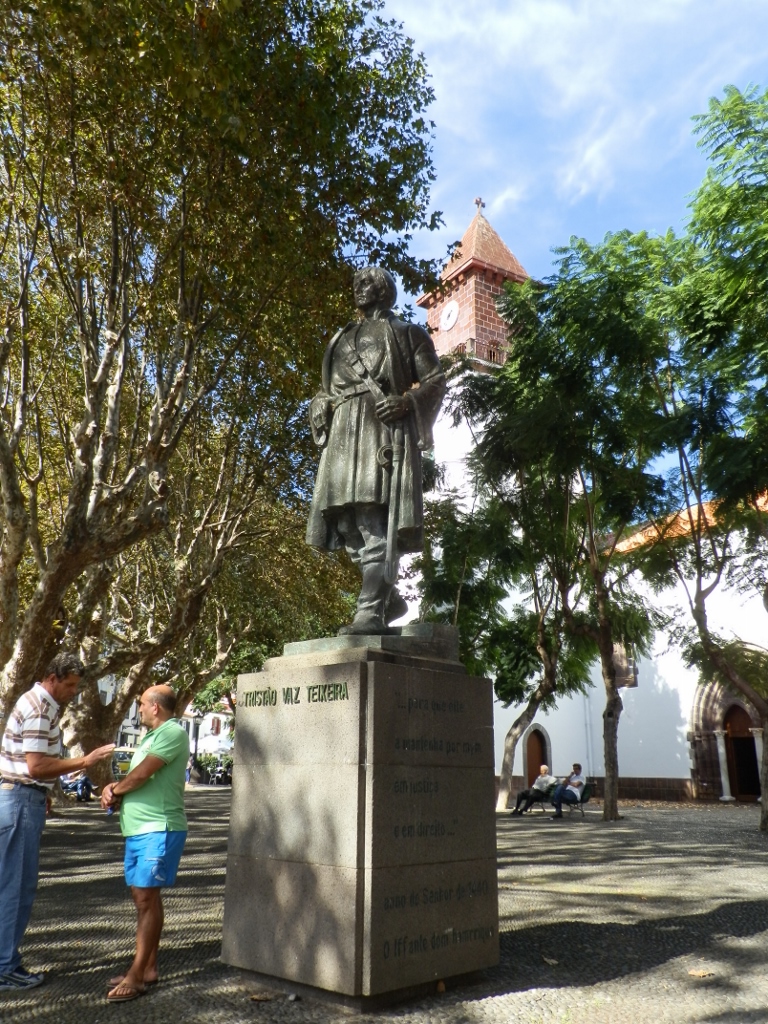 Teixeira’s statue with the Church of Our Lady of Conception in the background
Teixeira’s statue with the Church of Our Lady of Conception in the background
As I was not in the greatest of moods (I still had sore throat), I did not even wish to go into the church in this place, but we did walk around a little, crossing over a small local river and thus reaching the Chapel of the Lord of Miracles (Chapel of Senhor Bom Jesus dos Milagres). Although there are a couple of different accounts concerning the founding of this church, most likely it was built on the spot where there used to be an altar made after the discovery of Madeira since the leaders of the expedition wanted to thank Jesus Christ for the newly-discovered land.
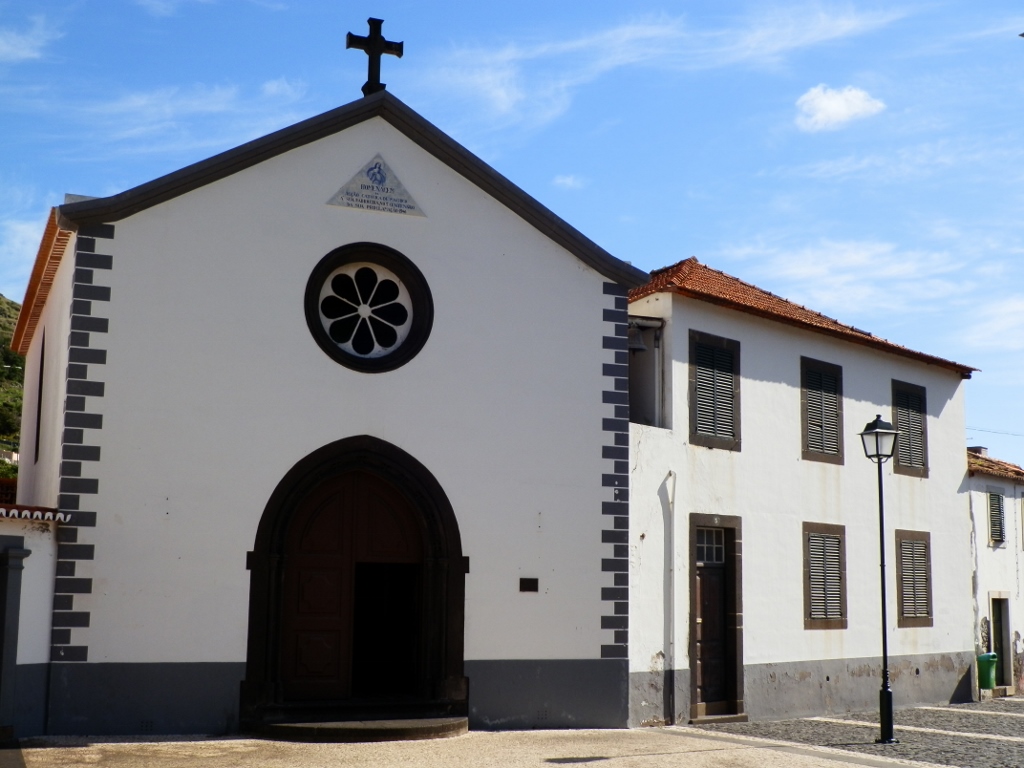 Chapel of the Lord of Miracles
Chapel of the Lord of Miracles
After this, Joao and I drove on eastwards to the Ribeira de Natal beach (Praia da Ribeira de Natal). As he told me, this was his favourite place for swimming. Admittedly, not the beach itself, but, as he explained, he liked to come to its end where there was a concrete jetty with steps which made it easier to get into the water and out of it. When you see this blue colour of the water, it all absolutely makes sense.
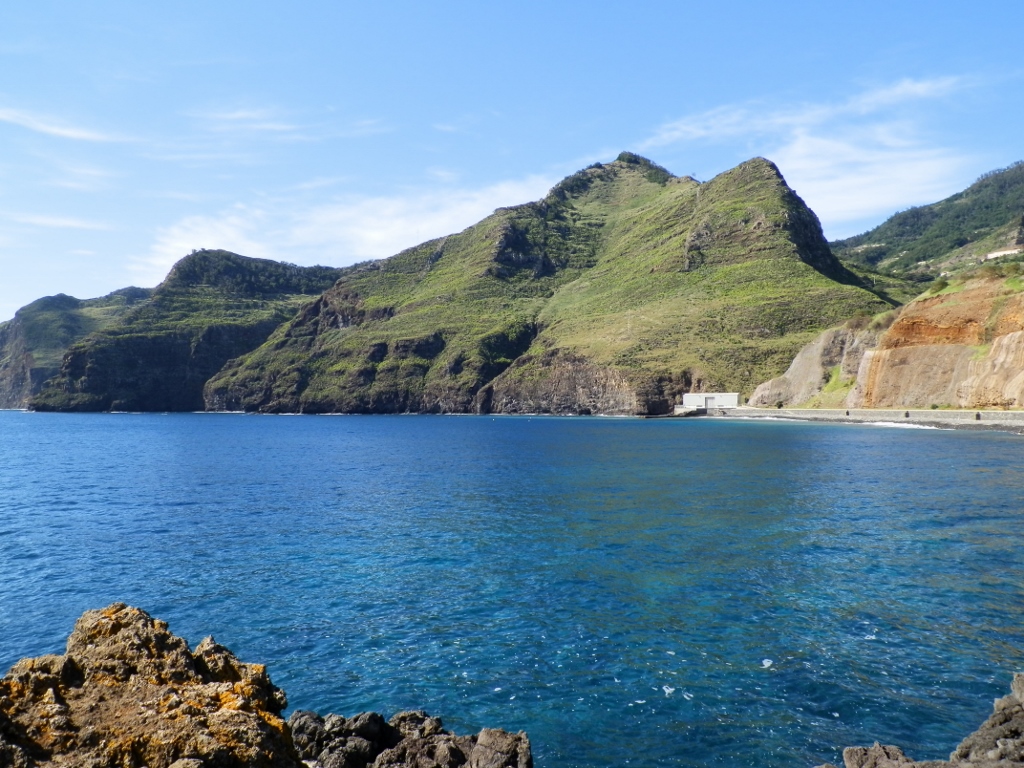 Praia da Ribeira de Natal bay
Praia da Ribeira de Natal bay
And then we headed for the far east of the island of Madeira. There is the Point of Saint Lawrence (Ponta de São Lourenço) after which there are a few more islets. This is a rugged, often very rocky headland. In order for me to see this well and take photos from one side, we made a stop at a viewpoint called Ponta das Gaivotas.
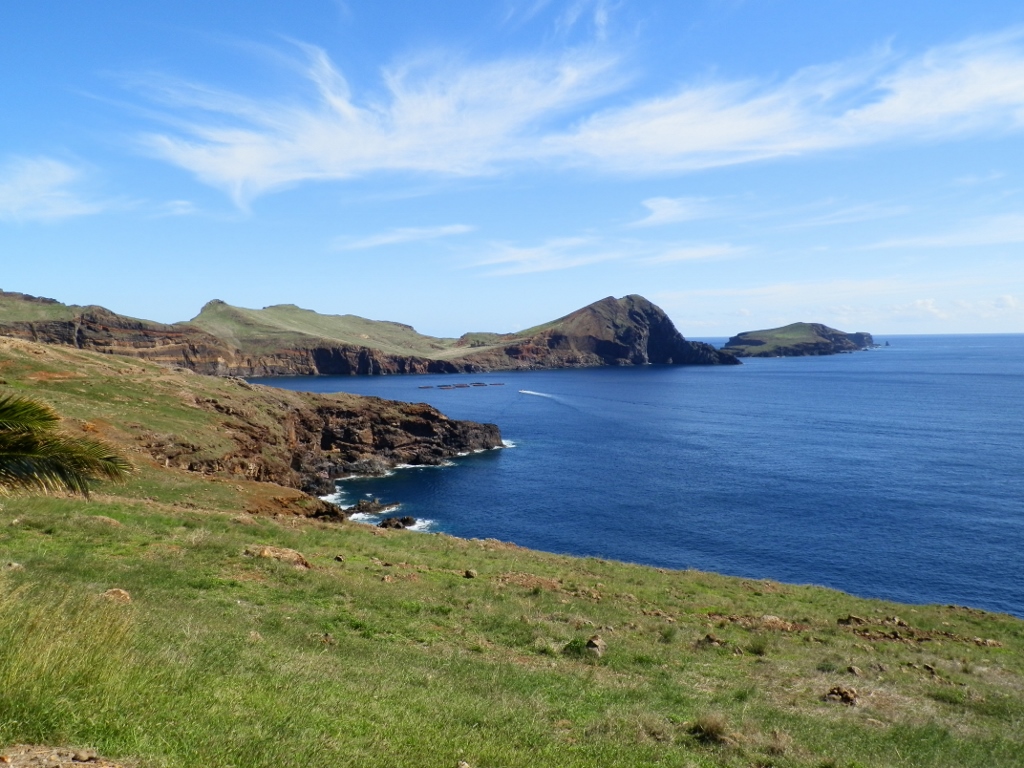 Ponta de São Lourenço
Ponta de São Lourenço
As the day was clear, from that viewpoint I could nicely see on the horizon the Desertas Islands (Ilhas Desertas). I have already mentioned them before, but it’s not a bad thing to reiterate it. These are three long, but narrow islands. They are practically uninhabited since the living conditions on them cannot support longer stay of humans. Nowadays, there is a nature reserve on them. Because of all of this, visits to these islands that are some 25 km away from Madeira are permitted only with a special permit.
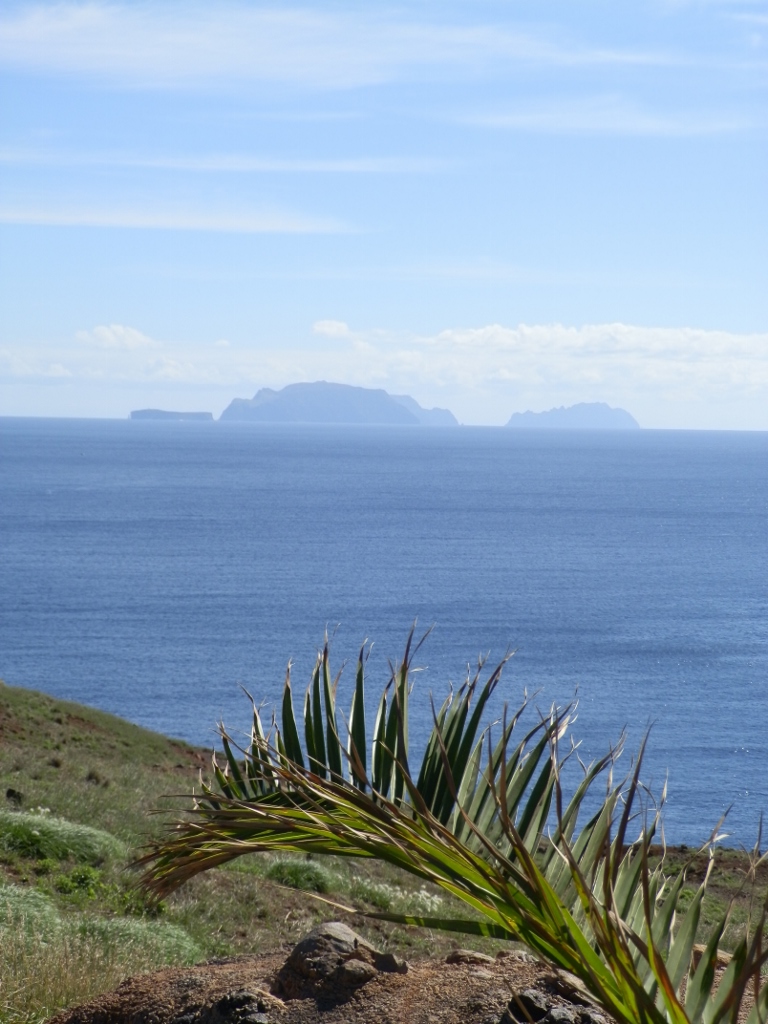 Ilhas Desertas in the distance
Ilhas Desertas in the distance
As I’m mentioning one nature reserve, let me say that the Point of Saint Lawrence is also a nature reserve and there are several endemic plants growing there, as well as some small, but interesting fauna. After this stop at the viewpoint, we drove to the end of that road where there is a roundabout so that vehicles can elegantly turn for going back and we parked our car there and got out. A very nice thing about this part of the island is that one can go on hiking tours and this is certainly something I am going to do the next time I go to Madeira. It’s all nicely marked and developed, plus there is this broad expanse and it is difficult for one to get lost.
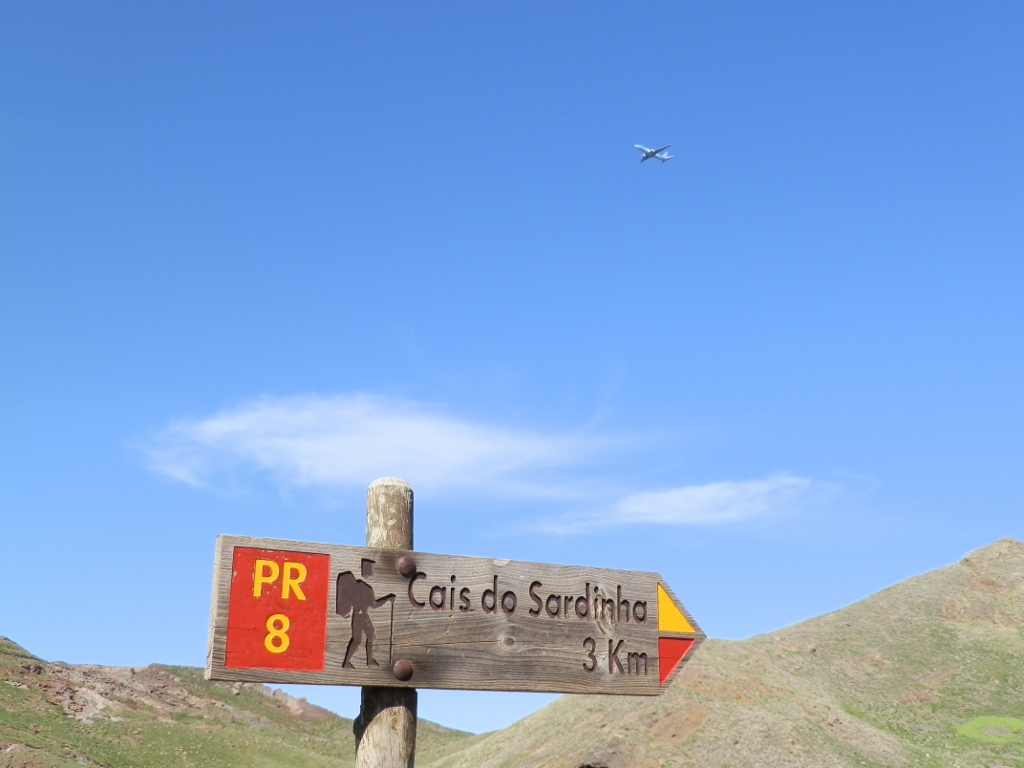 Signpost for hikers
Signpost for hikers
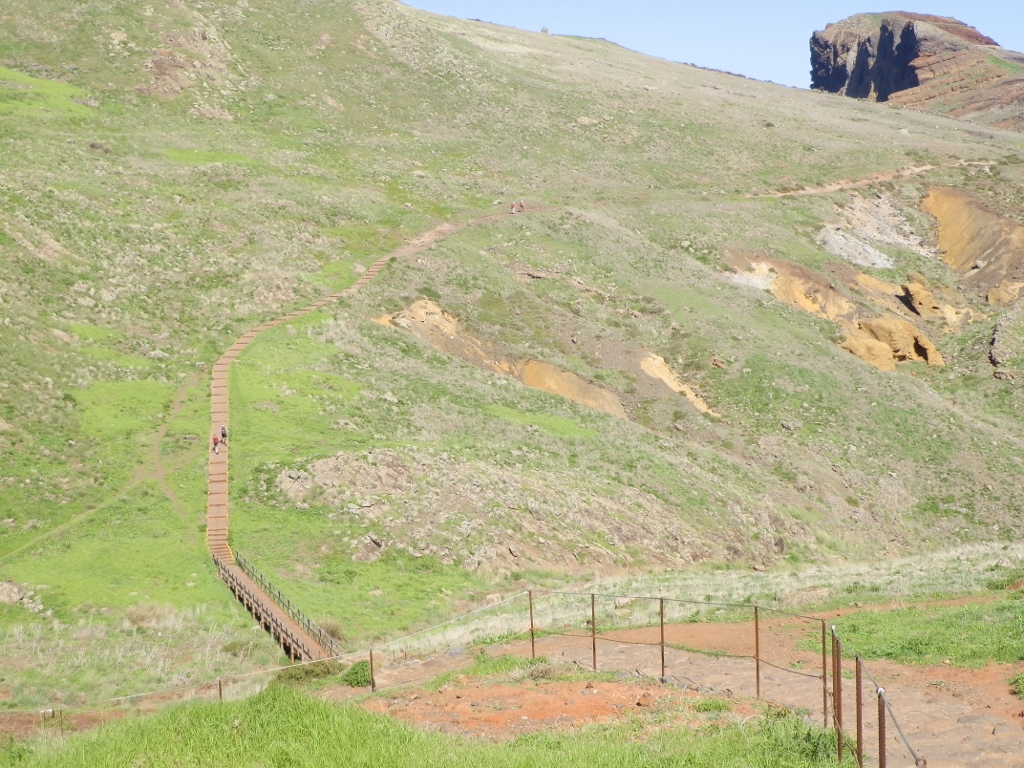 Hiking path
Hiking path
As I took note of the paths I will walk the next time, Joao and I went back to the car and then we had to drive a little on the same road in order to move a little later to the north side of the promontory. Along the way I could see a little better a large 5-star resort which has its marina, as well as a church and a lighthouse.
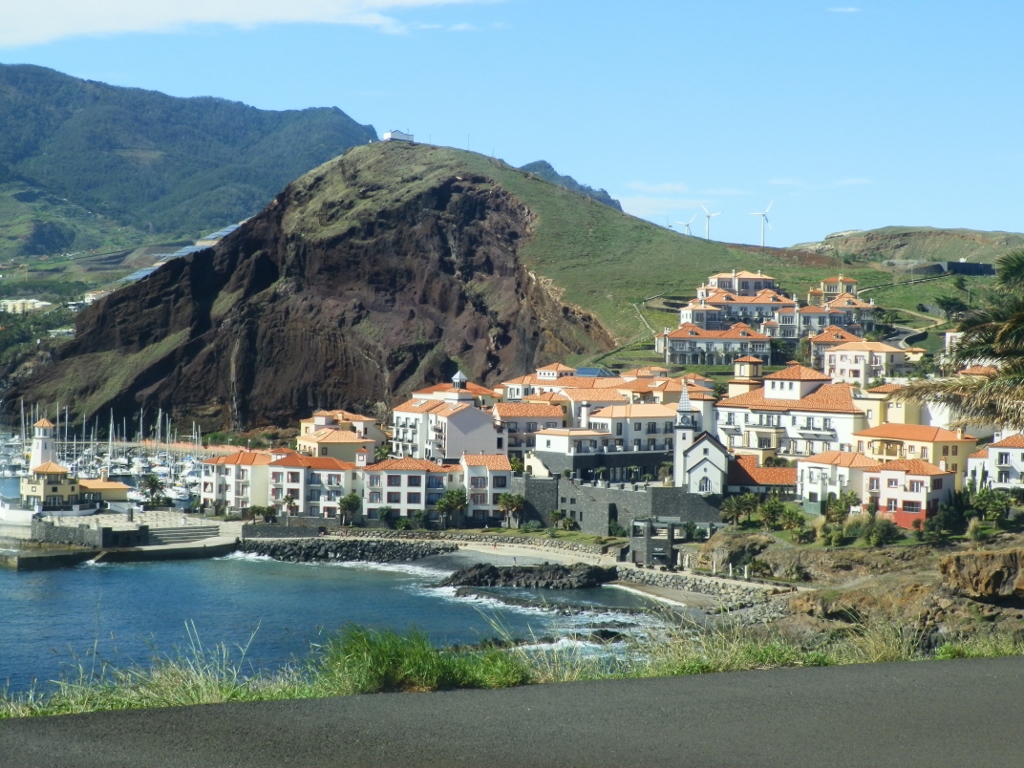 Tourist resort
Tourist resort
We were much more interested in nature that is spectacular here. In a way, very low key and yet fantastically beautiful. Thus we got to the end of this section of the road and parked the car there. From that point it is possible to see well the beginning of the headland and the rest of the east part of Madeira.
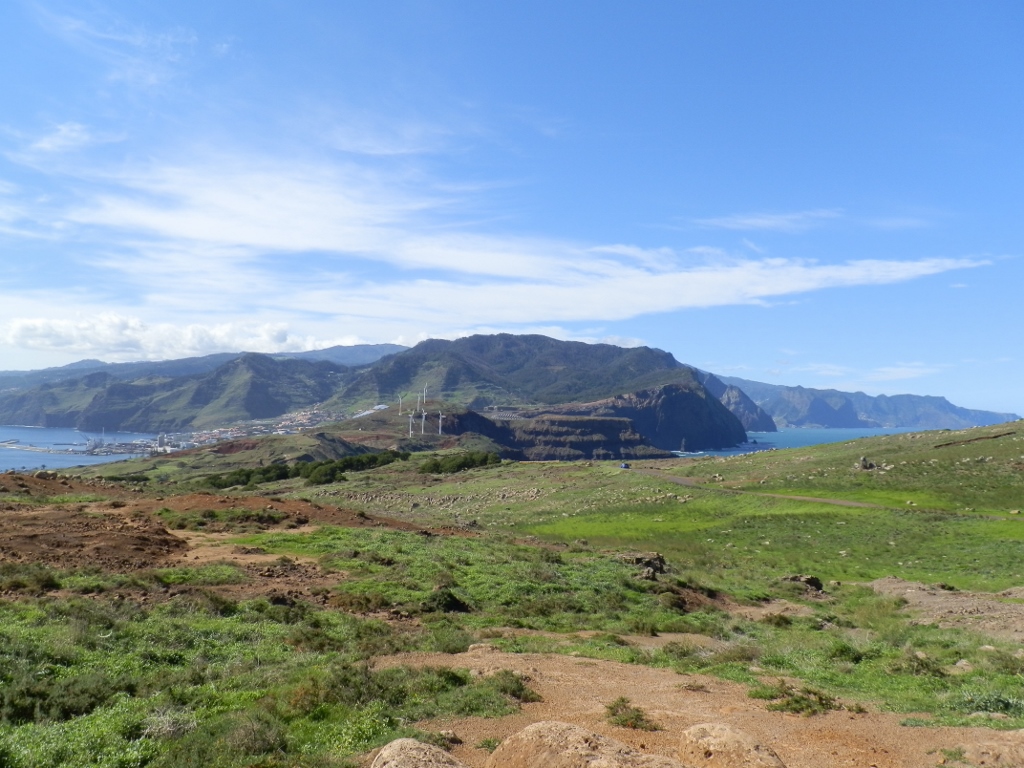 View at Madeira from Ponta de São Lourenço
View at Madeira from Ponta de São Lourenço
In the photo above, the south coast of Madeira is on the left-hand side, while its north coast is to the right. The following photo shows some details of the north coast.
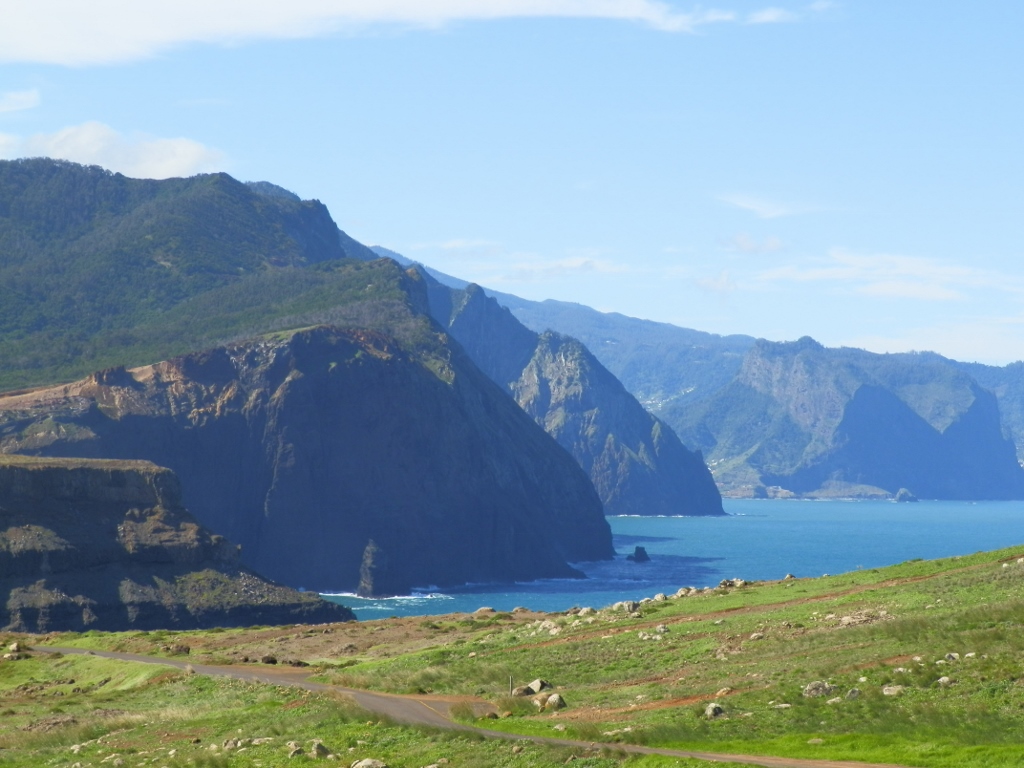 View at the north coast of Madeira
View at the north coast of Madeira
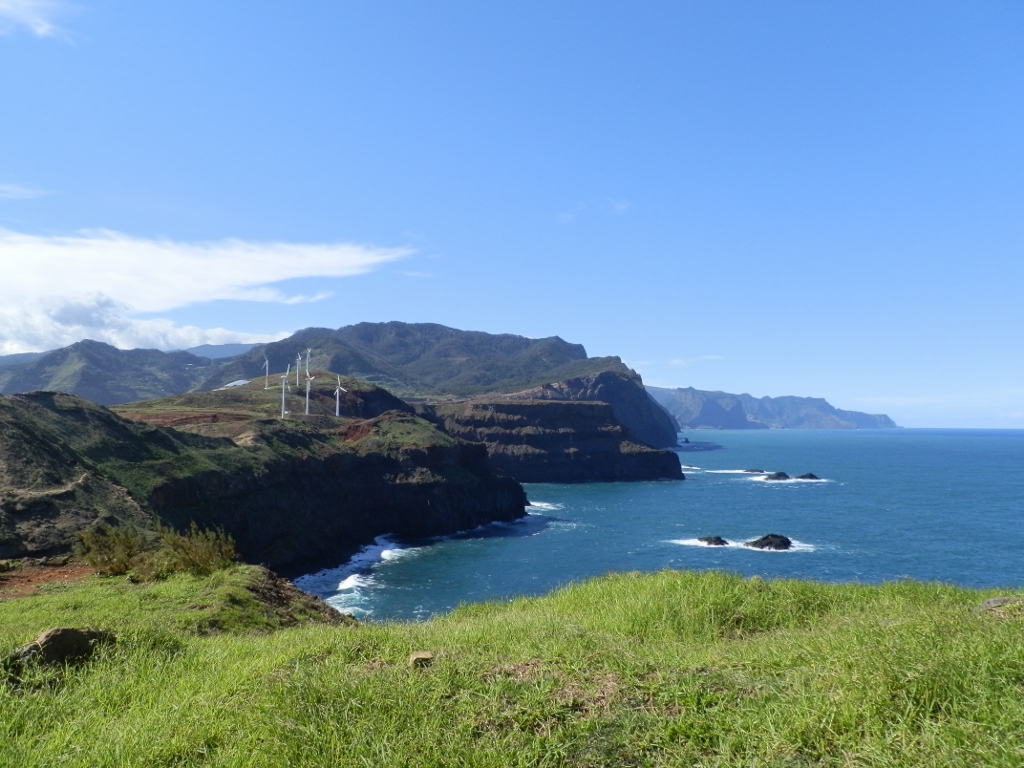 View at the north coast of Madeira
View at the north coast of Madeira
However, the main reason for coming here is the spectacular view at the north side of the Ponta de São Lourenço and the rocks that like spikes protrude from the Atlantic.
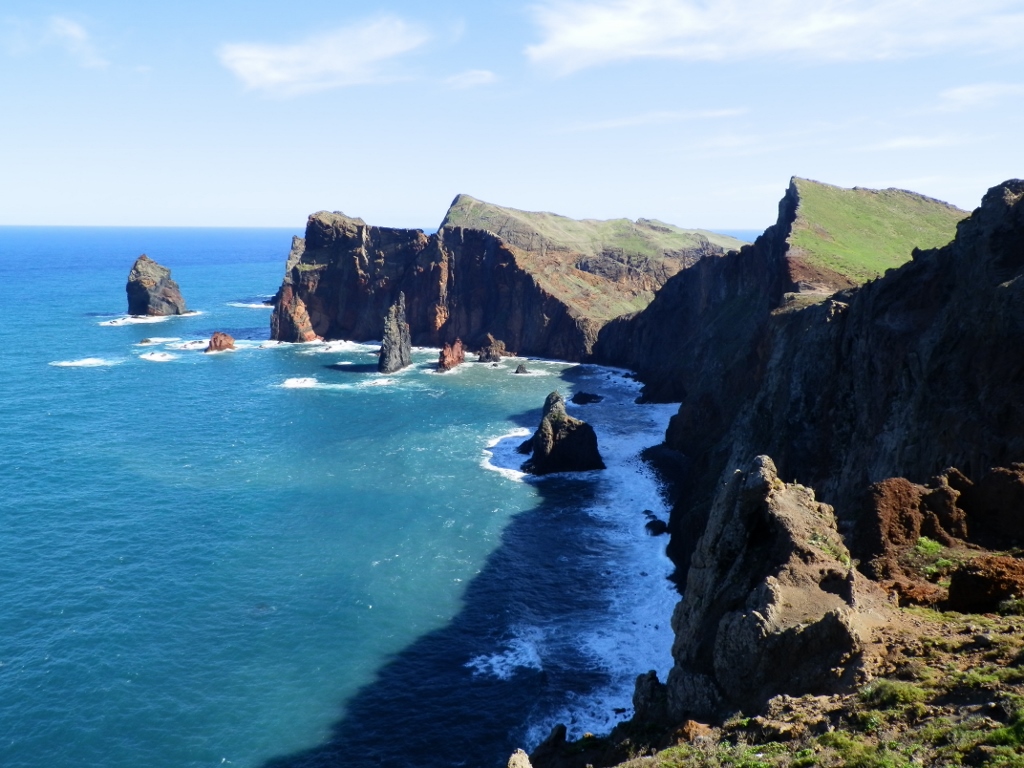 View at the north side of Ponta de São Lourenço
View at the north side of Ponta de São Lourenço
Already at the parking lot there is a broad fenced plateau from which these rocks may be looked at, but it is also nice to walk uphill a little to the very Ponta do Rosto Viewpoint (Ponta do Rosto).
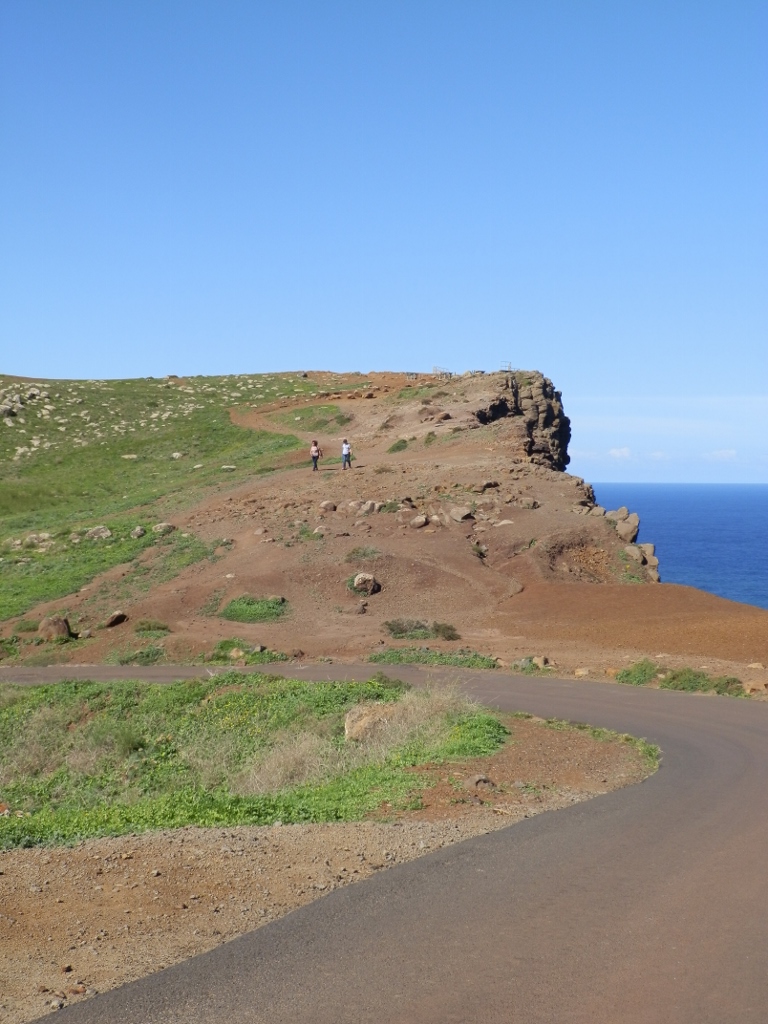 Path leading to the Ponta do Rosto Viewpoint
Path leading to the Ponta do Rosto Viewpoint
When you get to the top of the path, the view is stunning and there are also places where one can pose nicely.
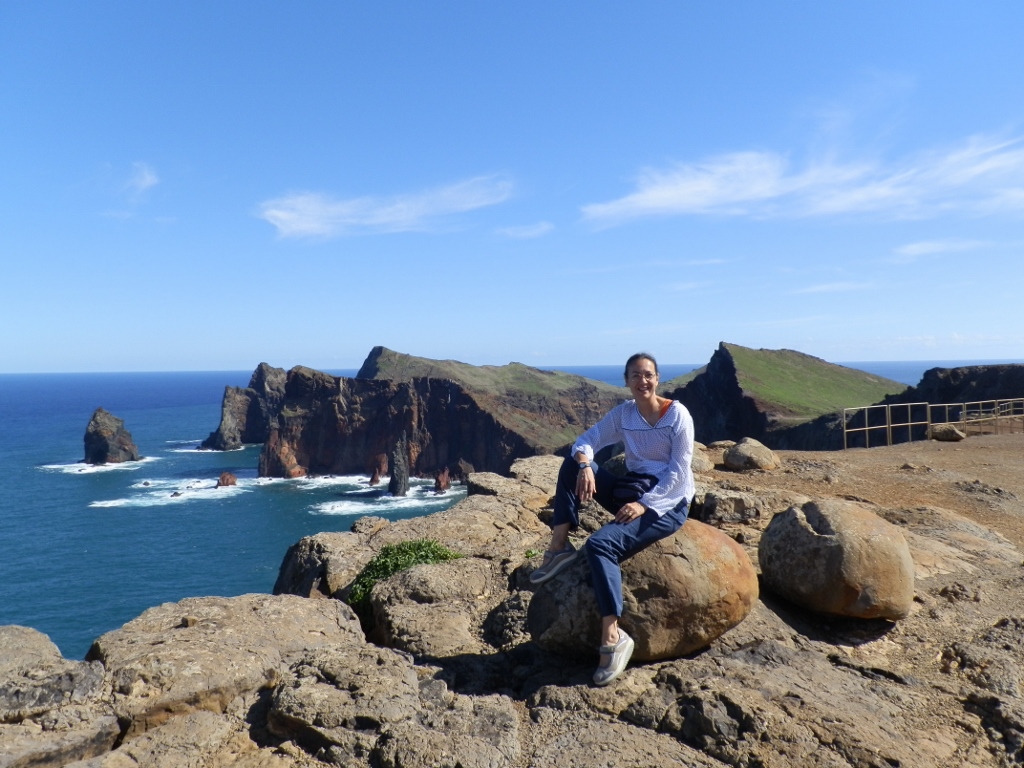 At the Ponta do Rosto Viewpoint
At the Ponta do Rosto Viewpoint
Although the day was sunny and decently warm, there was a strong wind here. As I was feeling relatively bad, I felt like coming down with something, this cooling did not feel great and after the posing I put on my jacket. It turned out to be a wise move because, regardless of the other steps I took later in order to stabilise my health, this warming up was of key importance for the full recovery and returning to normal that followed afterwards.
Bearing in mind how often we made breaks in order to see something and take photos, after this enjoying in a wonderful place, the gentle sunshine and perfect air, Joao and I realised it was time to eat and so we made a stop at a restaurant along the way. We both ordered a light lunch and that was enough for one not to be hungry and yet not to feel too heavy.
The next destination on our excursion was town Porto da Cruz on the north coast of Madeira and the road took us through hilly and green landscapes.
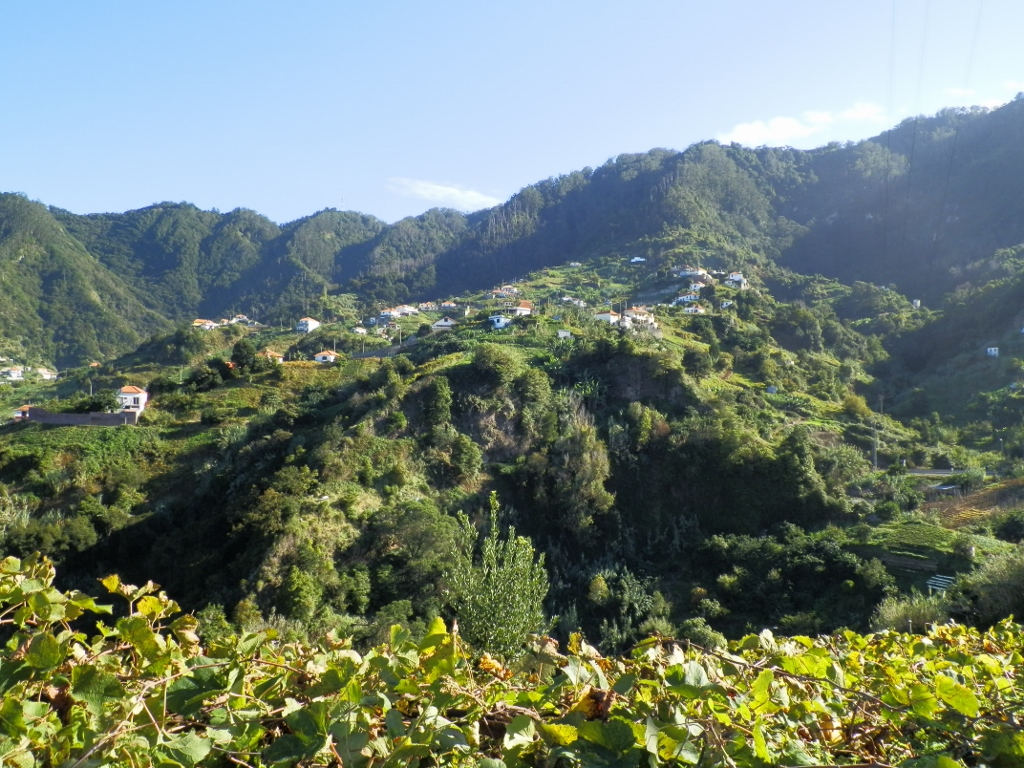 North side of Madeira
North side of Madeira
Porto da Cruz was founded in 1577 and one of the main activities here ever since the early settlers is growing of sugarcane. Where there is sugarcane, there is alcohol. And so in the centre of the town there is a historic building from 1927 in which there is production of spirits made of sugarcane – aguardente and rum. These are relatively similar drinks, but as far as I could gather aguardente is stronger and less sweet than rum.
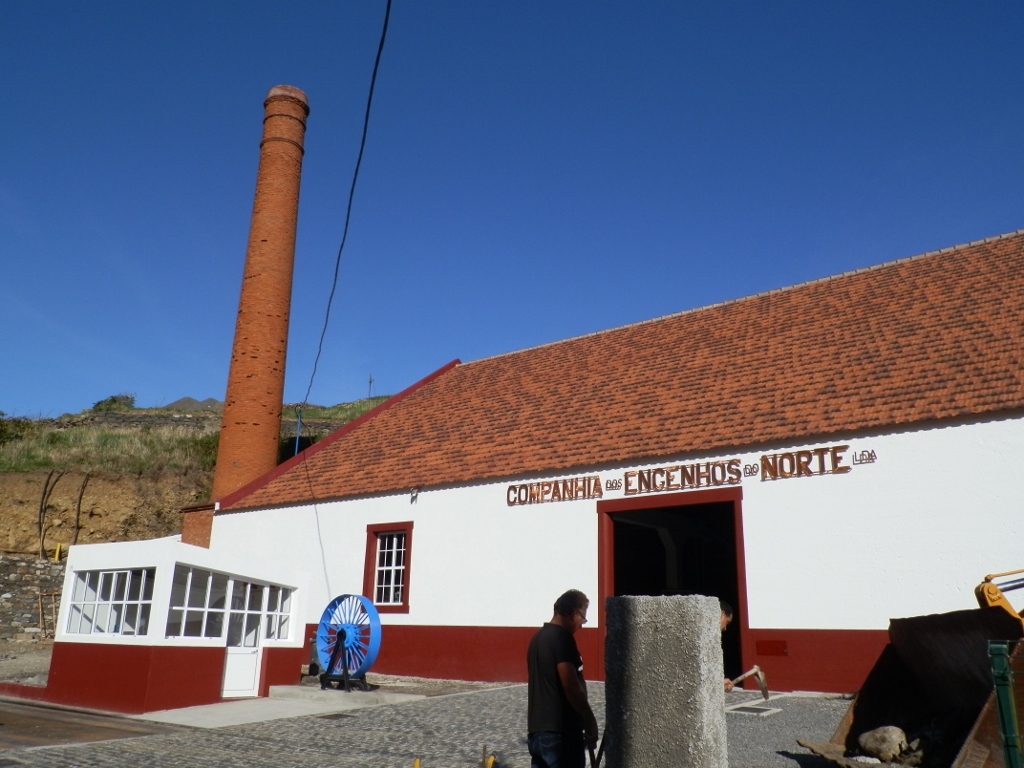 Old factory of spirits
Old factory of spirits
Walking around Porto da Cruz I passed by beautifully blossoming bushes of candelabra aloe (Aloe arborescens).
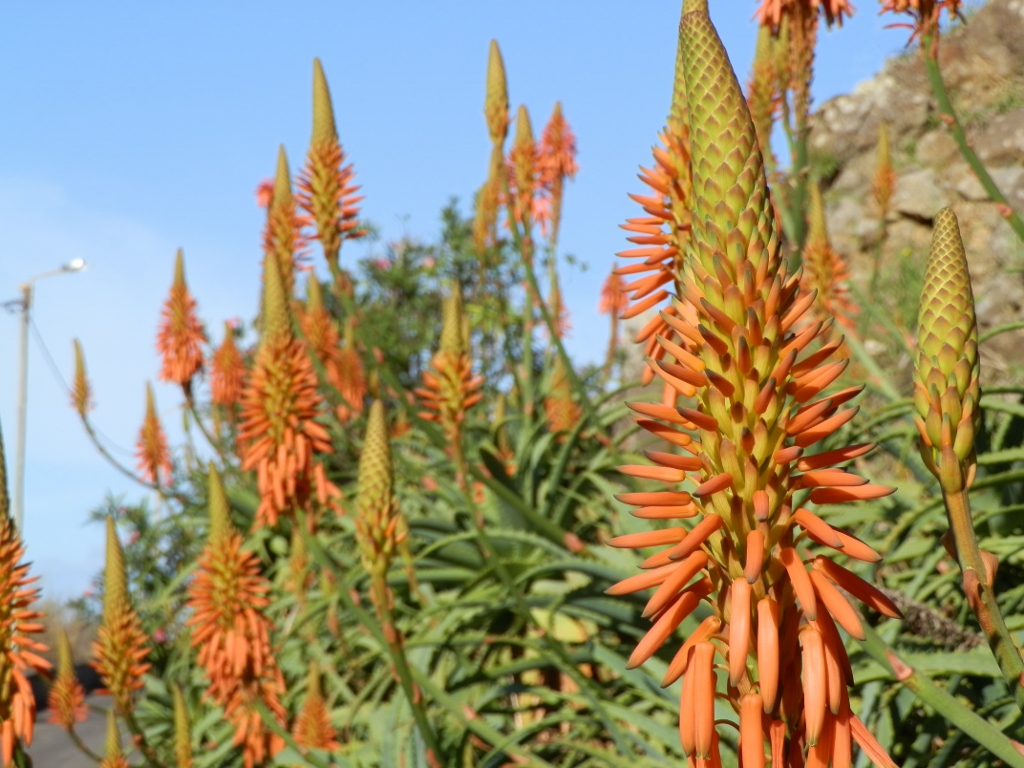 Candelabra aloe bushes and blossoms
Candelabra aloe bushes and blossoms
When one gets to the shore in Porto da Cruz there is a smaller promontory with places to swim on both sides. On the one side there is the Alagoa Beach (Praia da Alagoa)
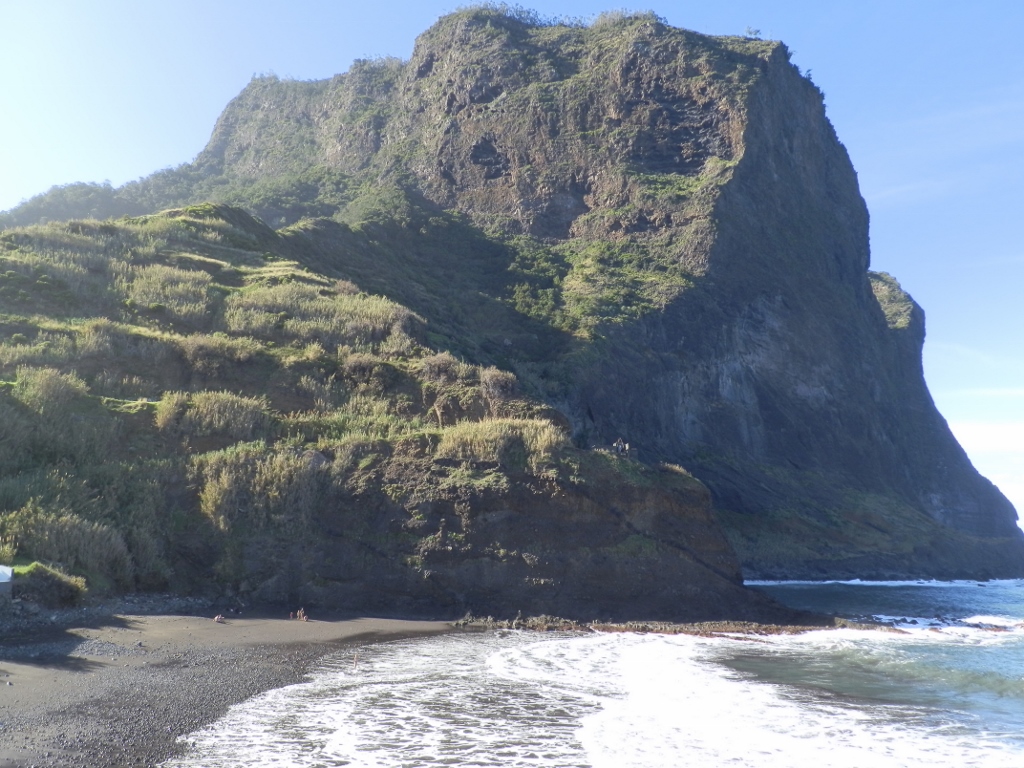 Alagoa Beach
Alagoa Beach
While I was standing there watching the beach, I noticed only one boy in the water practicing surfing.
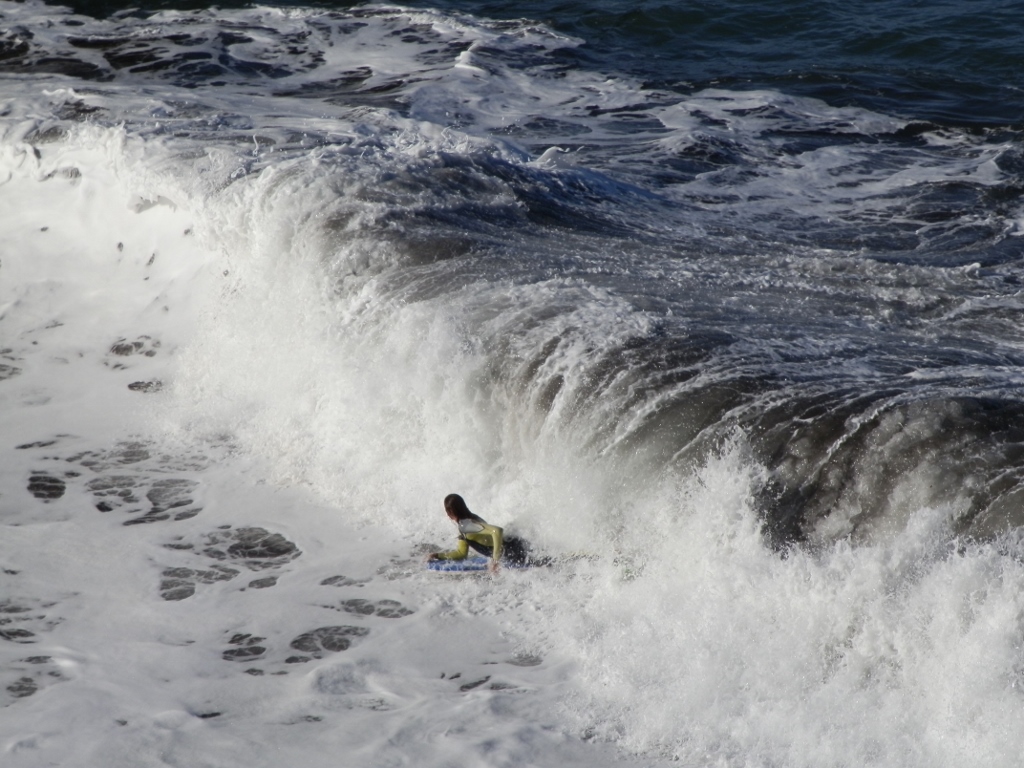 Practicing surfing
Practicing surfing
Joao and I then went to the other side of the promontory from which there is a fine view at the bay by Porto da Cruz and the surroundings, while in the distance one could see the rocks by Ponta de São Lourenço.
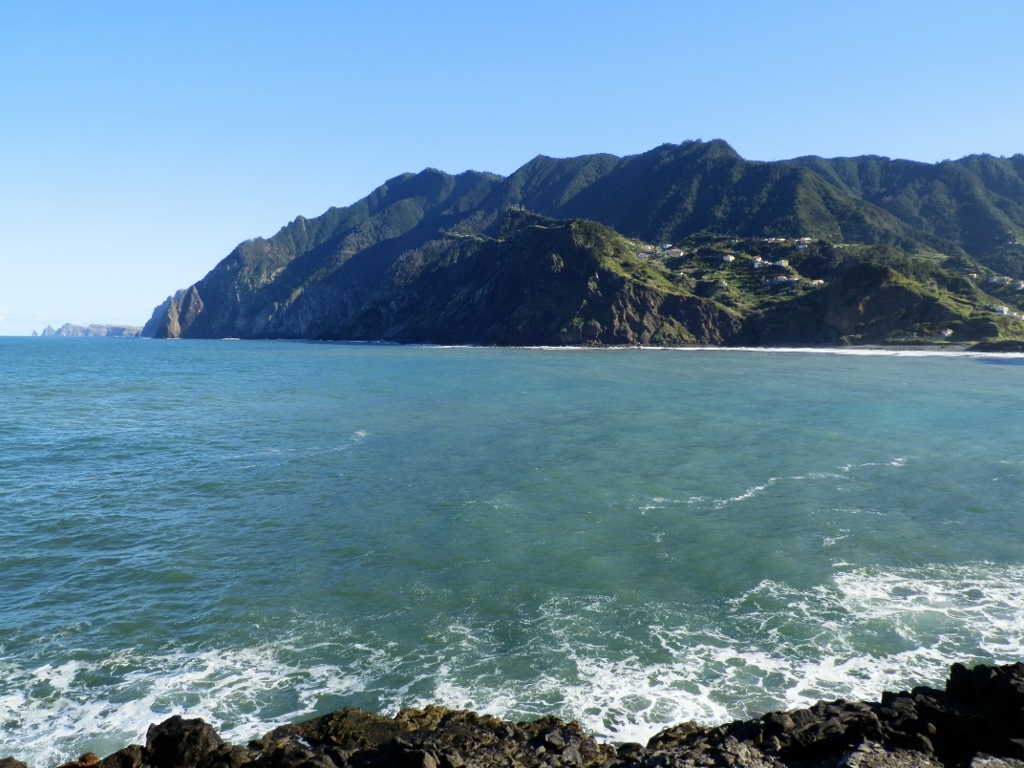 Bay by Porto da Cruz with the rocks by Ponta de São Lourenço to the left
Bay by Porto da Cruz with the rocks by Ponta de São Lourenço to the left
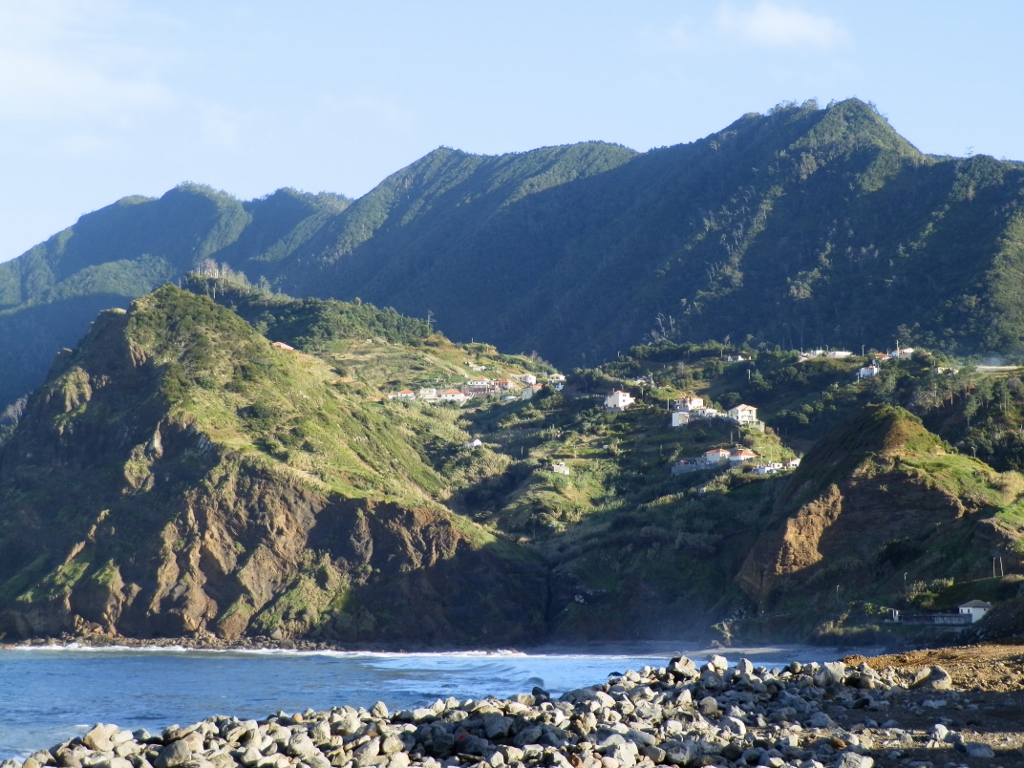 Surroundings of Porto da Cruz
Surroundings of Porto da Cruz
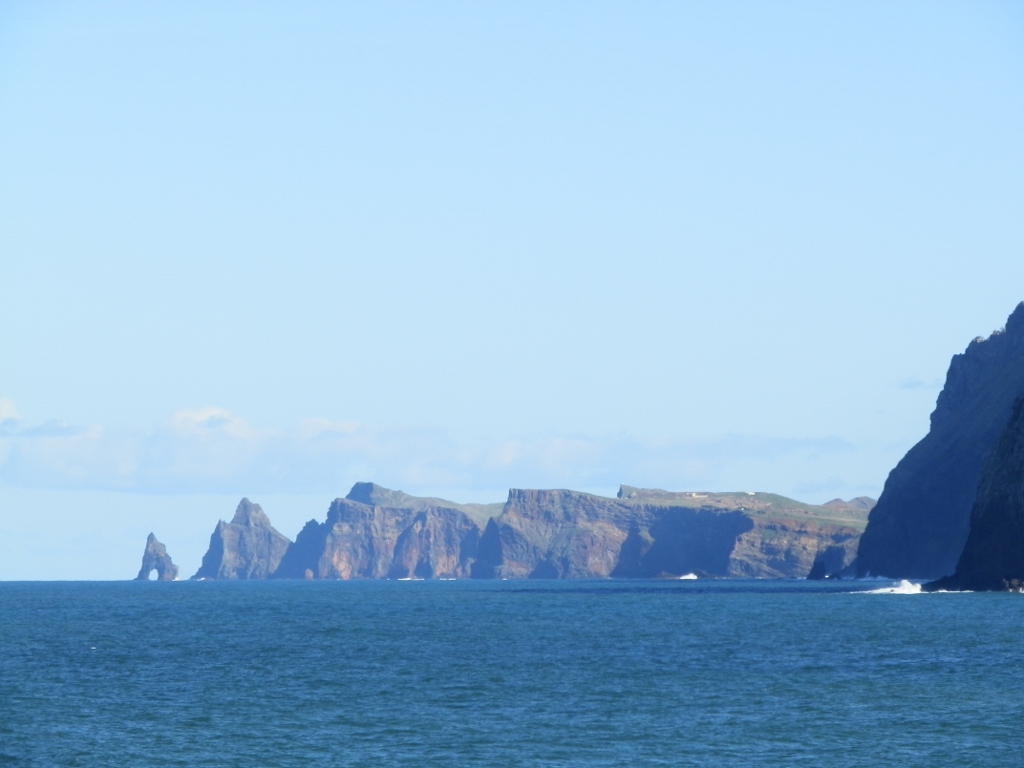 Rocks by Ponta de São Lourenço
Rocks by Ponta de São Lourenço
Since we had already had lunch, now was the right time for Joao and I to sit at one of the numerous cafés-restaurants by the shore in Porto da Cruz in order to enjoy the nice view and the sipping of coffee.